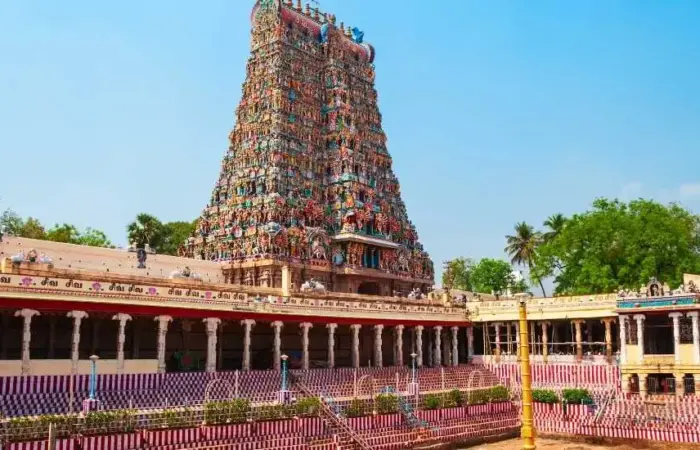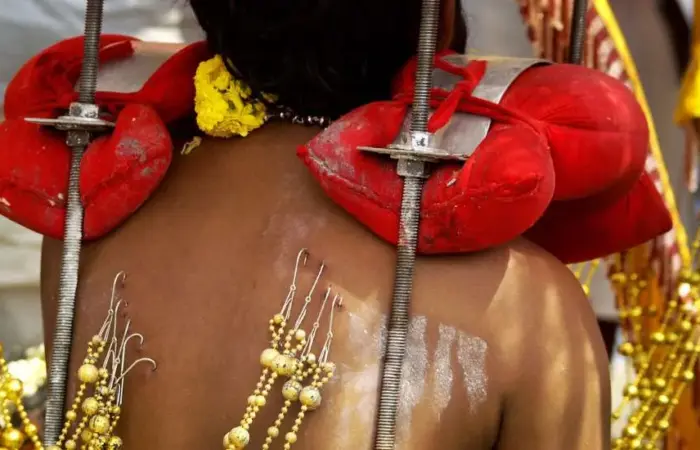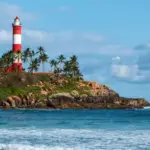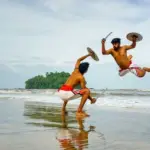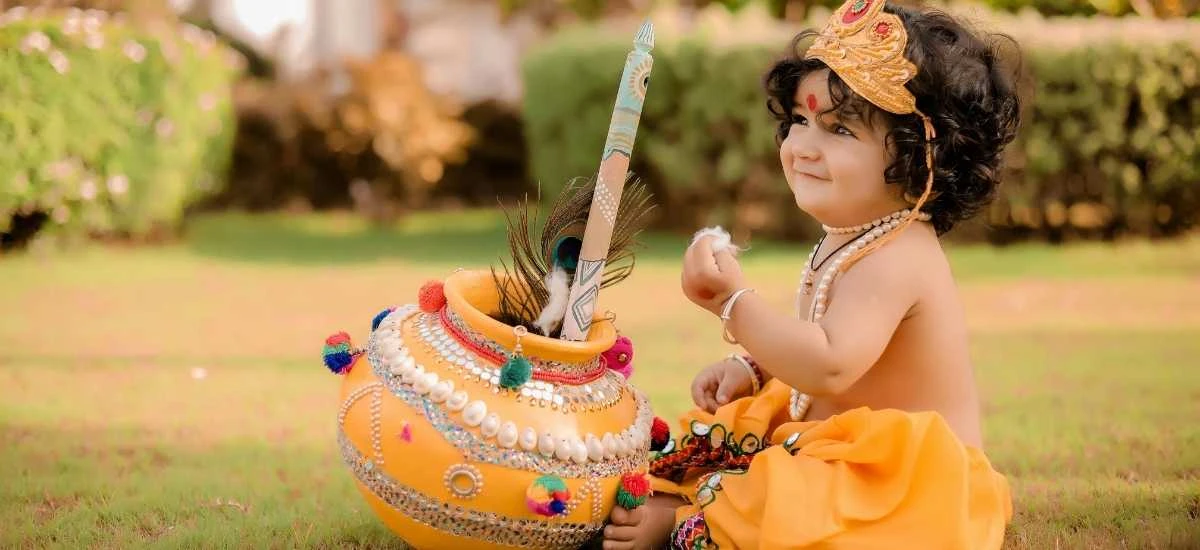
The birth of Lord Krishna is widely celebrated in India with great devotion and fervour as Krishna Janmashtami. It is mainly observed on the eighth (Ashtami) day of the Krishna Paksha in the month of Shraavana or the dark fortnight of the month of Bhadrapada, which overlaps with August and September according to the Gregorian calendar.
The holy festival of Janmashtami has arrived. Lord Krishna is revered in the entire nation, and this festival is gloriously celebrated with bhajans, prayers, and dancing in devotion. You must be busy planning where you should travel on this auspicious occasion. If you are in South India during the Janmashtami days, then there are a few famous Krishna temples that can be a part of your festival celebrations this year.
The festival is celebrated in a grand manner all across India, especially in Mathura, Vrindavan, and Dwarka. The actual celebration of Krishna Janmashtami takes place at midnight with devotional songs and dances, pujas, arti, blowing of the Conch, and rocking the cradle of baby Sri Krishna, as it is believed that Lord Krishna was born on a dark, stormy night.
On the auspicious day of Janmashtami, Krishna temples and shrines will be decorated with leaves and flowers, Krishna idol is placed in a cradle and taken out in procession and bathed with panchamrit which is a mix of milk, ghee, gangajal, honey and Tulsi leaves, dressed in new clothes, and prayers, bhajans and kirtans takes place at the temple along with satsangs. Then, sweetmeats are offered to the Lord, which are then distributed as Prasada among the devotees.
Dahi Handi is another fascinating part of this festival in which an earthen pot (Handi) filled with butter, milk, yoghurt or dry fruits is suspended with the help of ropes at a fair height, and people make a human pyramid and climb on each other to break the Handi. Though it is a re-enactment of the mischievous activity of Krishna as a child, stealing butter, the Dahi Handi ritual shows the unity and teamwork of the people. And the Janmashtami Festival symbolises bringing people together, thereby strengthening the brotherhood, harmony, and unity among each other.
Legend of Krishna Janmashtami:
Lord Krishna is considered the eighth and most powerful incarnation of Lord Vishnu. And the supreme objective of Lord Krishna’s birth was to save the world from the sinfulness of demons.
As per Hindu mythology, Sri Krishna was born in prison to Devaki and her husband, King Vasudeva of the Yadava clan. During this time, Mathura was under the rule of an evil king named Kansa, who was Krishna’s maternal uncle. It was predicted that wicked Kansa would be killed by Devaki’s eighth child. Krishna was their eighth child, and all the seven children who were born to them were killed by Kansa. Vasudeva, who knew that Krishna’s life was in danger, took the baby to Gokul and handed him over to foster parents, Yashoda and Nand, thus saving him from King Kansa. Krishna, when he grew up, fulfilled the sole objective of his life by killing Kansa. Hence, the Janmashtami Festival marks the victory of good over evil.
Guruvayur Sri Krishna Temple, located in Guruvayur, Kerala, is one of the revered Krishna temples in India. The deity residing here is a four-armed Lord Krishna with a conch, discus, mace, and lotus. He also adorns a basil garland. Guruvayur is considered the Dwarka of South India. Udupi Shree Krishna Matha Lord Krishna in this temple is highly worshipped by His devout followers. One of the popular Krishna temples in South India, this idol is famous for being decked up with jewels.
ISKCON Temples are internationally renowned Krishna Temples that comprise an important part of South Indian tourism. ISKCON Temples are present all over the world, while in South India, you can cover those in Chennai and Bangalore this Janmashtami. Ambalappuzha Sri Krishna Temple, located in Alleppey, is dedicated to Lord Krishna, who is known as Parthasarathi. The deity here holds a whip and a conch in both hands. The payasam and the sweet pudding served here have mythological significance.
Rajagopalaswamy Temple, one of the renowned Krishna temples of South India, is situated at Mannargudi in Tamil Nadu. Rajagopalaswamy is the idol at the temple, a form of Lord Krishna. It is also known as Dakshina Dwarka.
Balakrishna Temple, one of the famous Krishna Temples of South India, was constructed by Krishnadevaraya after his victory over Utkala. The main idol established there is now displayed in the Chennai State Museum.
Venugopala Swamy Temple, another ideal Krishna temple of Hoysala architecture, is located in Mysore, Karnataka. It is located beside Krishnaraja Sagara Dam in Mysore. Janardanaswamy Temple, one of the oldest temples of South Indian tourism, is 2000 years old. Situated in Varkala, the temple is also considered to be an important Ayurveda centre.
Padmanabhaswamy Temple is located in Thiruvananthapuram, Kerala, India. The temple is built in an intricate fusion of the indigenous Kerala style and the Tamil style of architecture associated with the temples located in the neighbouring state of Tamil Nadu, featuring high walls and a 16th-century Gopuram.
Vadaku Thamaraikulam Krishna Aalayam temple was constructed in 2005 and can be a beautiful place to visit during Janmashtami. It is situated in Kanyakumari and comprises an important part of South India tourism.
How people in India celebrate:
The festivity and merriment of Krishna Janmashtami take place for two days. The first day of the festival is known as Krishna Ashtami or Gokul Ashtami. As Krishna was born at midnight, the celebrations start at night with fasting, followed by a traditional prayer. The second day is the Kaal Ashtami or Janmashtami, which involves decorating temples, chanting prayers, devotional songs, recitals, dances, and feasting. Krishna Janmashtami is greatly admired all across India, but the name of the festival and its celebrations vary from place to place.
Uttar Pradesh:
Mathura and Vrindavan are the much-sought-after places in the north Indian state of Uttar Pradesh, where you can witness the celebrations of Krishna Janmashtami with all its splendour and magnificence. Mathura is believed to be the birthplace of Lord Krishna, and Vrindavan is where Krishna is believed to have grown up.
With grand and imposing decorations and elaborate ceremonies, Shri Krishna Janmabhoomi and Dwarkadheesh temples in Mathura, as well as the Banke Bihari, ISKCON, and Radha Raman temples in Vrindavan, offer you unforgettable memories of the Janmashtami Festival.
Unlike other places, the festivity of Janmashtami here continues for a week. The temples are decorated grandly days before the festival. Raslila – folk dance-drama depicting the life of Lord Krishna is enacted in many places during the festival. Krishna idol is bathed with milk, honey, curd, which is known as Abhishek, then dressed up in new clothes, and embellished with jewellery and placed in beautifully decorated cradles. And there creates a divine ambience filled with devotional songs, hymns, and prayers. People also offer 56 dishes of Prasada, known as Chappan Bhog, to Lord Krishna to appease him. They also take part in the Dahi Handi ritual, which makes the festival so lively and enthusiastic.
Gujarat:
The grandeur of Krishna Janmashtami can also be experienced at the city of Dwarka in Gujarat, also known as the City of Lord Krishna. The Dwarkadhish Temple, dedicated to Lord Krishna, attracts a lot of devotees during this festival.
The Mangal Arti performed in the morning is a significant part of the celebration. People take fasting, and there will be programs like Garba dance, recitation of devotional songs, and Raslila performances leading up to midnight. Here, the Dahi Handi ritual is known as Makhan Handi, and the earthen pot is filled with yoghurt, which is suspended at some height from the ground. The men who gather to make a human pyramid are called Govindas, and they will climb up to break the pot and spill the yoghurt, which is then offered to everyone as Prasada. It is a thrilling activity to watch, and swarms of people gather around cheering Govindas. Various teams compete in the Makhan Handi ritual, and the winners are awarded cash prizes. To make the task more challenging, the spectators throw buckets of water at the human pyramids.
Maharashtra:
In Maharashtra, Krishna Janmashtami is popular as ‘Gokulashtami’. Cities like Mumbai and Pune celebrate it with much fervour and pomp. Here, Dahi Handi is also known as Makhan Handi, and the celebrations are similar to those of Gujarat.
Odisha and West Bengal:
It is Sri Krishna Jayanthi or Sri Jayanthi in Odisha and West Bengal. Like other places, here also the celebrations go on till midnight with fasting and reciting the tenth chapter of the Hindu scripture Bhagavata Purana. And the second day of the festival starts with Nanda Utsav, which is the celebration of Krishna’s foster parents, Nanda and Yashoda. Chappan Bhog is offered to the Lord on this day.
Manipur:
People in Manipur also celebrate Krishna Janmashtami with fasting, recitation of scriptures, vigils, and the Raslila dance. There will be special prayers at the famous ISKCON and Shree Govindajee temples on this day.
South India:
In South India, the Krishna Janmashtami is celebrated in quite a different way from that of North India. People observe a full day of fasting and break the fast at midnight.
In Kerala, this festival falls on the Rohini asterism in the month of Chingam of the Malayalam Calendar. In Kerala, this year it falls on August 23. There will be processions of young boys dressed up as Krishna with crowns on their heads and carrying flutes, and young girls dressed up as Radha. Here, the Dahi Handi ritual is known as ‘Uri Adi’, and instead of yoghurt, ‘Unniyappam’, a sweet dish, is put in the earthen pot.
In Tamil Nadu, they celebrate by drawing beautiful decorative patterns on the floor called Kolam and footprints of Krishna at the entrance of the house. Like Kerala, in Andhra Pradesh, young boys dress up as Krishna during the Janmashtami festival. They offer fruits and sweets first to the Lord and later distribute them among people.


